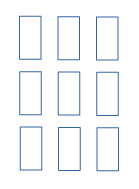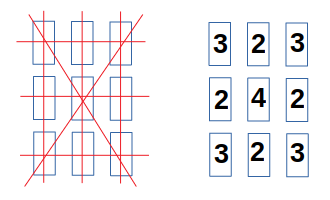Tic-Tac-Dice and Tic-Tac-Super-Dice -- Original Dice Games
Invented by Howard Fosdick (V 1.1) © BestFreeNewGames.com
Here are two easy but fun dice games based on Tic-Tac-Toe. Instead of drawing circles and crosses, you throw dice to determine which squares you can claim on a board composed of face-up playing cards. Tic-Tac-Dice takes the trivial game of Tic-Tac-Toe and transforms it into something more exciting and strategic. Tic-Tac-Super-Dice adds more challenge.
Tic-Tac-Dice
For: 2 players.
Equipment:
- Two dice
- Two sets of about 10 markers for each player. You can use different coloured poker chips for each player, or checkers or Go pebbles of different colours. Or use pennies for one player and nickels for the other.
- One deck of playing cards
To create the card deck you'll use for this game, take a standard 52 card pack and remove all cards above the 8. So you'll end up with 32 cards, ranking Ace-2-3-4-5-6-7-8. The Ace has a value of 1 in this game.
Objective: To complete a single row -- vertically, horizontally, or diagonally -- on a Tic-Tac-Toe board composed of playing cards.
Set Up: Roll both dice to see who goes first. (After the first round, the person behind goes first.)
Then deal out 9 cards face up in this pattern on the table:

Play: In his turn, a player roles the two dice.
He then places one of his markers over a card in the layout whose number matches either of the numbers he has thrown. Or, over or a card that matches their sum.
For example, a role of 2-3 can be considered as either a 2, 3, or 5. The player must place a marker on a card that is either a 2, 3, or 5.
The player is required to claim a card if possible. If he can not, he places no marker on the board, and it becomes his opponent's turn.
If a player throws doubles, he claims a card (if possible), and takes another turn. This can continue for as long as he rolls doubles.
Winning: The first player to create a row of three markers -- vertically, horizontally, or diagonally -- wins the hand or "round". He gets 2 points for the victory.
If a round ends where neither player completes a row with his markers, whichever player has more markers on the board gets 1 point for a "win on points".
If both players have the same number of markers, the hand is a draw and no points are awarded.
Game: The first player to 5 points first across rounds wins the Game.
Analysis: Classic Tic-Tac-Toe, played with pencil on paper, is a dull, predictable game.
If you go first, just put your X in any corner. Unless you're opponent counters by drawing his O in the center, you'll win.
If you go second, you're at huge disadvantage. Unless your opponent makes a big mistake, the best you can play for is a draw.
Tic-Tac-Dice transforms this simple game into something more challenging because turns become unpredictable. Dice rolls dramatically shape options. Players must always take a card if possible. This sometimes forces unfavourable moves, or at least suboptimal ones.
Sometimes it happens that a square everyone knows a player needs may be denied him by a poor dice roll. And then his opponent immediately claims it on his roll.
Such unpredictability transforms simple Tic-Tac-Toe into a contest of greater strategy and intensity. Excitement builds as players hope for dice that fulfil their strategies.
The left-hand diagram below shows all possible paths to winning.
The right-hand diagram below shows how many intersections occur in each position. The higher the number, the more valuable a position.

But simply "going by the numbers" may not result in optimal play. While luck is key, you can bend the odds in your favor by adapting your strategies to an ever-changing board, and properly assessing and playing the percentages.
Variation -- Increase the size of the board to a square of 4 cards by 4 cards (instead of 3 by 3).
Tic-Tac-Super-Dice
This related game presents greater complexity and requires more strategic thinking.
Rules are the same as in Tic-Tac-Dice except:
2. Use the entire deck of 52 cards. From low to high, the cards rank: 1 (ace), 2, 3, 4, 5, 6, 7, 8, 9, 10, 11 (jack), 12 (queen), 13 (king).
3. Each player rolls 3 dice (instead of 2). Players can use any single die, or any additive combination of either two or three dice, as their number for their turn. For example, for a roll of 1-3-6, valid plays are: 1, 3, 6, 4, 7, 9, and 10. Another example: for a roll of 1-2-3, valid plays are: 1, 2, 3, 4, 5, and 6.
4. If a player rolls doubles (a pair), he gets exactly one extra roll after his initial roll. If he rolls a triplet (3-of-a-kind), he gets exactly two extra rolls. Unlike Tic-Tac-Dice, a player can not continue his turn indefinitely by repeatedly rolling doubles.
Analysis: The left-hand diagram below shows the 10 possible rows that could be completed to win the hand. The right-hand diagram shows how many paths each position participates in:

Variation -- Some prefer to play without Kings in the deck. This avoids prolonged efforts to roll a 13.
License: Feel free to print, copy, and distribute these rules, so long as you retain this paragraph. Invented by Howard Fosdick © 2023, distributed under Creative Commons License BY-ND. HOME